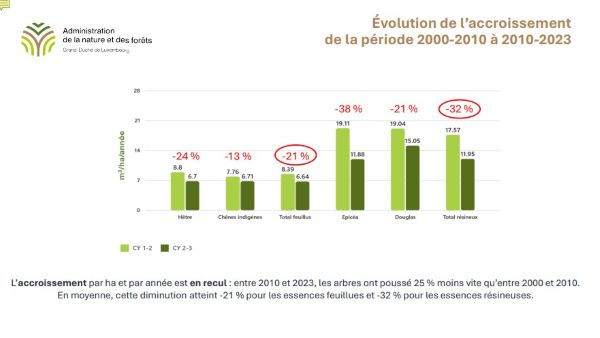 Evolution of growth increment from the period 2000-2010 to 2010-2023;
Credit: ANF
Evolution of growth increment from the period 2000-2010 to 2010-2023;
Credit: ANF
On Thursday 27 November 2025, Luxembourg's Minister for the Environment, Climate and Biodiversity, Serge Wilmes, together with the Nature and Forest Agency, presented the results of the third cycle of the National Forest Inventory (Inventaire forestier national - IFN 3), showing declines of forest growth between 2010 and 2023.
The inventory, carried out between January 2023 and July 2024 on 1,845 sampling points by consulting firms specialising in the forestry sector, provides detailed information on the state of Luxembourg’s forests and highlights the challenges linked to climate change.
According to Luxembourg's Ministry of the Environment, Climate and Biodiversity and the Nature and Forest Agency, the national forest inventories of 2000, 2010 and 2023 serve as a reference for monitoring Luxembourg’s forests. They help to track changes in forest area, tree species, forest structure, standing timber volume and biodiversity indicators. These data support forest policy and help to ensure sustainable management.
The results of IFN 3 show that the forest area has remained stable over the years, currently covering around 35% of the territory (92,250 ha), with a balanced distribution between public forests (49.5%) and private forests (50.5%).
The adaptation efforts carried out in forest stands over the past two decades are starting to show results: the share of broadleaved species has risen from 66% in 2010 to 75% in 2023, and forest structure has become more diverse, with a wider mix of species and more multi-layered stands.
Since 2000, the number of old and large-diameter trees has doubled, reaching nearly 135,000 forest stands in 2023. However, the amount of deadwood has also increased from 6m³ to 27m³ per hectare. These elements play a crucial role in forest biodiversity, as old trees and deadwood provide essential microhabitats for many specialised species.
While the increment in standing timber volume is higher than in 2000, it has fallen compared with 2010. Broadleaved stands show a 21% decrease in volume increment and coniferous stands show a 32% decrease. Timber volume followed the same pattern: it rose by 18% between 2000 and 2010 but is now more than 6% below the 2010 level. Over the past 23 years, the total growth of timber stock has reached only 11%, even though stands have aged and the average tree diameter has increased. Between 2010 and 2023, forest growth volume also fell by 25% compared with 2000-2010. Calamities, dieback and bad weather conditions have contributed to this decline.
Between 2010 and 2023, Luxembourg’s forests emitted more carbon than they absorbed, becoming a net source of CO₂ as a result of climate-related damage and the harvesting of spruce stands affected by bark beetles. Prolonged droughts increased tree mortality and supported bark beetle spread, leading to clear-cutting of spruce rising from 850 ha in IFN 2 to 2,050 ha in IFN 3.
Regarding the future of Luxembourg’s forests, Minister Wilmes stressed the need to adapt forest management to new climatic realities in order to guarantee stable, diverse and resilient forests capable of providing all ecosystem services and supporting the timber sector. Priority measures include strengthening the diversity and complementarity of species, maintaining genetic diversity, increasing structural diversity, improving tree resistance to disturbances and adapting infrastructure to future conditions.
Luxembourg adopted a new Forest Law on 23 August 2023, which establishes the principles of sustainable management for all forests, both public and private. Based on the results of IFN 3, the ministry is currently finalising the national forest programme. In addition, a specific aid scheme has been established to support private owners in the conversion of forest stands.
"The challenges are considerable but thanks to collective mobilisation, we can preserve our forests for future generations and ensure their essential role in biodiversity, climate protection and the sustainable use of wood resources," Minister Wilmes said during the presentation.
EO








